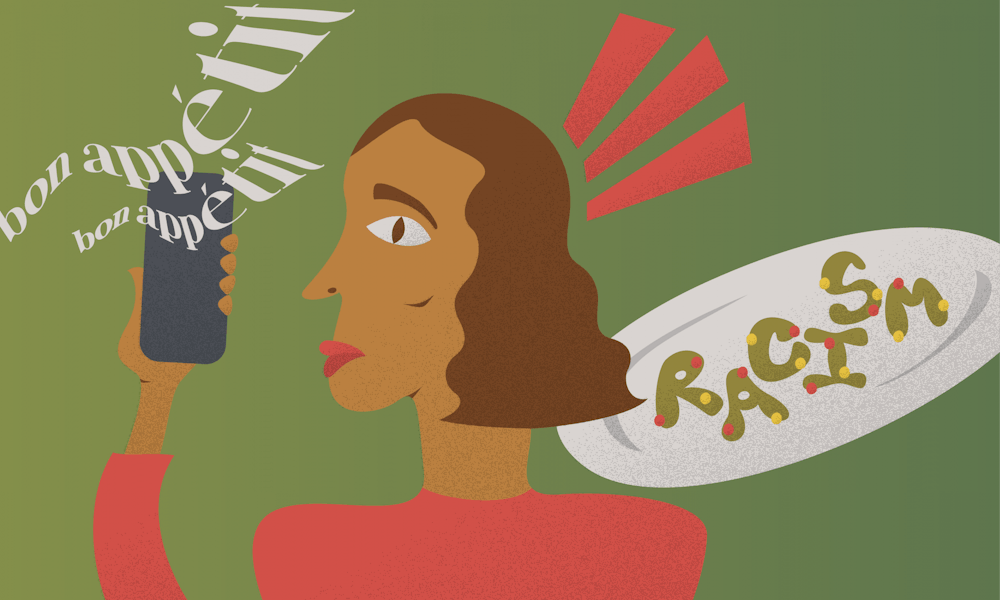On a Saturday afternoon last year when my quarantine boredom was officially at its peak, I stumbled across a video on my YouTube recommendations page that would shape my life for the next few weeks. The thumbnail featured colorful Skittles, one of my favorite snacks. After clicking on it, I was greeted with the words that would play in my head over and over again for a long time: “Hey everyone, I’m Claire, and today we’re in the test kitchen.”
I grew up obsessed with cooking shows such as MasterChef and Chopped, but I never considered myself a good cook—my past experiences in the kitchen always ended up poorly, whether it was a burnt cake or an overly salty scrambled egg. That never stopped me from turning on the TV every week and watching amateur and professional chefs use their natural knack for taste and presentation to create vibrant, appealing dishes. Thus, when I discovered the Bon Appétit channel, I was determined to learn from the experts and make food that I enjoyed from scratch.
Gourmet Makes, a series in which the host Claire Saffitz attempts to recreate and elevate everyday snacks such as KitKats or Cheez–Its, quickly became my new set of videos to binge. I made my way through 40 videos, watching as Claire constantly experimented with the amount of flour to use and struggled with tempering chocolate. To be completely honest, I found it much more fun to watch Claire cook rather than to actually make the snacks myself; when I tried to make Claire’s gourmet Oreos that were deceivingly simple given the two–minute recipe, I remember thinking of giving up multiple times before reluctantly continuing and ending up with practically inedible clumps of sugar bricks.
Over time, as I checked out some of the series Bon Appétit had to offer, I became invested in this channel that almost mirrored comedy shows like The Office at times. Food became something fun to me again, and during quarantine when I had more time to explore my hobbies, I was encouraged to try a few new recipes—even if I usually ended up with a disappointing result. I finally felt adventurous and brave at something that I never considered before.
Soon into this obsession, I began to eagerly expect new Gourmet Makes videos given Claire’s fairly consistent schedule. I never got one. Instead, I was met with chaos: A few weeks after watching my first Bon Appétit video, the editor–in–chief of the company, Adam Rapoport, found himself at the center of a brownface controversy. Just days later, Sohla El–Waylly, a food editor at Bon Appétit, said that she and other employees of color were not being paid for some of their guest appearances while white employees were always paid. Suddenly, my journey with Bon Appétit became much more complicated; besides becoming knowledgeable about food, I also learned about the toxic work culture in the food and media industries, and how this and other factors contribute to the frustrating experiences minorities face.
As the controversy gained more media attention, more accounts of discrimination and unfair work practices were revealed. People who were regularly featured on Bon Appétit’s YouTube channel did not renew their contracts, and the company soon became a skeleton of what it once was. Bon Appétit played a big role in the rekindling of my love for cooking just like it did for many other teens and young adults, but that does not excuse how problematic the company is.
After a four–month hiatus, a video was uploaded to Bon Appétit’s channel titled “Why We Joined Bon Appétit,” showcasing a new leadership board for the company featuring people of color. They were clearly trying to turn around their negative perception with a more explicit commitment to diversity, but not many were convinced; in December, the company found itself in hot water again after their recipe for soup joumou, a historically significant Haitian dish, was said to be culturally inauthentic. Additionally, the article’s introduction included the phrase “legend has it” to describe the background of the soup, dismissing its actual history and importance.
At the end of the day, Bon Appétit is making an effort to rebrand itself from its problematic past—but just like I learned in Gourmet Makes, rebranding and recreating are not as easy as they seem. It takes a lot of reflection, trial, and critical thinking to truly learn the process of reformation. My experience with Bon Appétit is still tainted with the company’s controversy, but I have hope that they will start treating their employees fairly and equally. Gourmet Makes taught me how to be a resilient cook, and now it’s time for us to teach Bon Appétit what it means to be resilient advocates by holding the company up to its standards.

